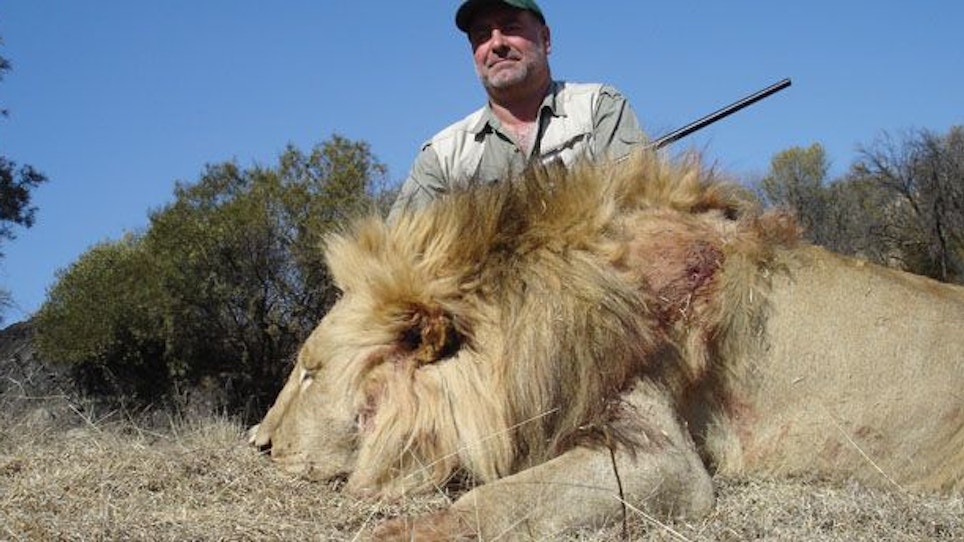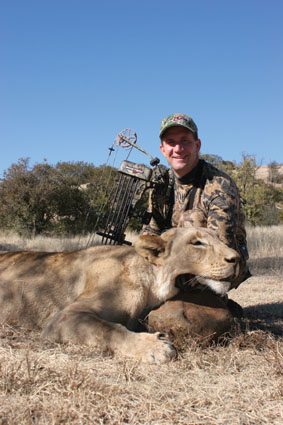 It was the middle of the night, and we'd been calling for several hours with no success. The pride of African lions had killed in the village the night before, and good friend Joel Hancock, a South African government problem animal expert and my hunting partner on the trip, wanted to put an end to it all. He'd been after this pride for weeks.
It was the middle of the night, and we'd been calling for several hours with no success. The pride of African lions had killed in the village the night before, and good friend Joel Hancock, a South African government problem animal expert and my hunting partner on the trip, wanted to put an end to it all. He'd been after this pride for weeks.
We'd secured a donkey for bait, tethering it to a lone tree on the outskirts of the remote village. At 2 a.m., as our dreary cold bodies were about to give up, a cat let out a roar that jolted us back to life. It was close to our blind, and we dared not hit the light.
The next sound we heard was crunching bone, and the sound of raspy cat tongues licking flesh. The pride had sneaked in, caught the donkey asleep, killed it without a sound, and commenced feeding.
We'd tied a bell around the donkey's neck, for two reasons. One, it served the purpose of a secondary call, for in addition to the tape-recorded domestic animal-in-distress sounds we played, the bell was something killer-cats, keyed in on, or so Joel thought. Second, had we dozed off and the cats moved in, the kicking donkey would ring the bell, ensuring we'd hear it. Neither scenario worked. The donkey fell asleep, and the first cat grabbed it by the throat, seizing the bell. It was over in seconds.
With at least one cat feeding on the donkey, and another roaring somewhere near our blind, we waited. Joel knew four, maybe five cats comprised this marauding pride, and wanted to know where they all were prior to turning on the light for a shot.
In The Beginning
Our wait seemed to take an eternity. As we quietly sat, listening to cracking bones and bloodcurdling roars in the night, I recalled the story Joel shared with me the day before.
One of Joel's first experiences with problem animals involved entailed a call on problem lions. He visited the remote village where he discovered the headman's wife had been the victim. An aggressive move by villagers forced the pride of seven cats off the body soon after the woman had been killed.
That afternoon, Joel slipped in against a towering termite mound near the original kill site. As dusk turned to dark, no cats materialized.
Finally, in the middle of the night, they approached – one cat here, another there, two over there. Casting the beam of his flashlight into the brush, seven sets of eyes appeared.
Surrounding Joel, the cats grew more aggressive. They knew he was there, but didn't care. They'd killed people before, and one more posed no threat. As the cats closed in, Joel knew what had to be done. His first shot smacked a big male and surprisingly, the rest of the pride continued coming. A second shot connected on another big tom, as did a third.
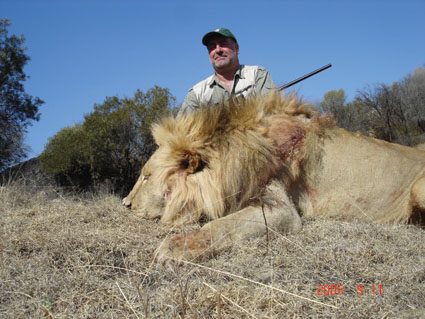 When the shooting subsided, all was silent. Joel had shot every lion, but wisely opted for daylight before heading into the bush to assess what happened. What must have been going through the minds of the villagers, who were within easy earshot during the incident, is something that can only be imagined. In South Africa at the time, villagers were not allowed to own guns and often relied on sticks, spears and fire to ward off threatening cats. These primitive predator deterrents were not always successful.
When the shooting subsided, all was silent. Joel had shot every lion, but wisely opted for daylight before heading into the bush to assess what happened. What must have been going through the minds of the villagers, who were within easy earshot during the incident, is something that can only be imagined. In South Africa at the time, villagers were not allowed to own guns and often relied on sticks, spears and fire to ward off threatening cats. These primitive predator deterrents were not always successful.
As dawn broke, Joel moved in to evaluate the situation. Four cats were dead and three blood trails lead into the bush. Gathering trackers from the village, Joel went after the wounded lions. The morning proved long and wore on his nerves. Very tense, close-encounter situations unfolded over the next few hours, but in the end, the remaining cats were tracked down and killed.
Joel's life as a problem animal control specialist epitomizes the pinnacle of predator hunting. He's taken more man-eating lions, leopards, hippos and crocs than most people will ever see of each species, and his stories are worthy of a novel. His world of predator hunting is not a game. In Africa, one mistake might mean the hunter’s death.
That's why, as I sat in the blind, waiting for Joel to shine the light on our situation, I felt confident and never questioned his decision to wait. Cats continued crushing bones, and soon sounds of contented purring drifted our way.
After several minutes, our dim light was turned on. At its edge, four cats lay, feeding on the carcass. One stood, and I nailed it with a .375. Within the next 30 minutes, two more cats were killed, but the final one took some work. Following it into the tall grass, Joel connected on a shot merely feet away. Had the head shot not dropped the cat in its tracks, someone would have been hurt, or worse.
Taking The Charge
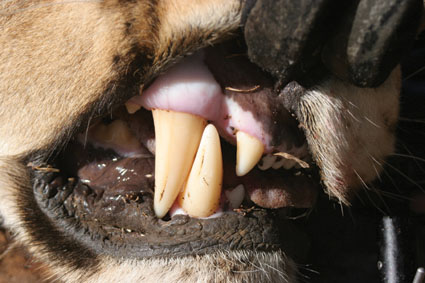 Joel's occupation is a dream job, a job that many of us would take for no salary. Today, though, the opportunities for lion hunting in South Africa are improving, thanks to sound management and government regulations that allow land managers to regulate their own properties. The result is plenty of lions, in growing numbers.
Joel's occupation is a dream job, a job that many of us would take for no salary. Today, though, the opportunities for lion hunting in South Africa are improving, thanks to sound management and government regulations that allow land managers to regulate their own properties. The result is plenty of lions, in growing numbers.
On my most recent African safari, I had the pleasure of hunting with Tam Safaris. The Tams offer what many believe is the best lion-hunting opportunities in all of South Africa. They attract cat hunters from around the globe. One of Tam Safari's Professional Hunters, Marnus Steyl, has guided many lion hunters over the years, and he knows hunt must be approached with utmost caution.
"You never know how a cat hunt will unfold," says Steyl. "Each hunt is different, and when you're dealing with fearless, aggressive predators like these, anything can happen."
Steyl has had many close encounters over the years, be it from cats charging before or after the shot, or even crawling into the blind with hunters. During a recent hunt, a client shot a big male lion too low in the leg. It broke his leg, but the cat ran off.
"That client was really shaking," notes Steyl. "It was a close, easy shot to make, but the fact it was a lion rattled the hunter; that's what lion hunting does to a person. As the cat turned and ran off, the client got one more bullet into him, but it was way back in the guts."
At this point the client opted out of the hunt, refusing to follow Steyl into the thick bush. "A tracker and I followed the spoor into a semi-dry river bed," continues Steyl. "There were small pools of water, and it was easy tracking as he went in and out of the water. Between the blood and wet tracks, it was a simple trail to follow. But then the cat crawled up a steep, dry bank and quit bleeding, and I lost the track."
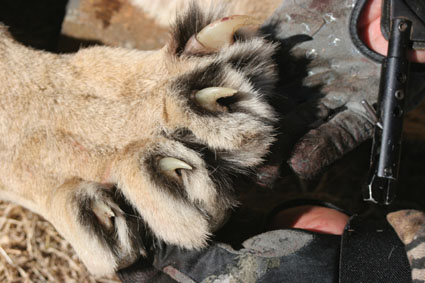 As Steyl worked up the bank and around some brush, something told him to stop and survey the area. "I looked back and there was the cat, not 10 yards from me," Steyl grimaced. "The moment we made eye contact, I knew it wasn't a good situation, but fortunately the cat turned and ran the other way. He was limping badly as he went into thick brush, but he disappeared so quickly that there wasn't even a chance for a shot."
As Steyl worked up the bank and around some brush, something told him to stop and survey the area. "I looked back and there was the cat, not 10 yards from me," Steyl grimaced. "The moment we made eye contact, I knew it wasn't a good situation, but fortunately the cat turned and ran the other way. He was limping badly as he went into thick brush, but he disappeared so quickly that there wasn't even a chance for a shot."
Steyl and his tracker followed the cat on hands and knees, crawling through thick tangles of brush. It was then that they heard the unmistakable, guttural sound of a half purr, half growl that a lion makes in warning.
"I'd say 99 percent of all crippled lions start making this purr-growl sound as you approach them," points out Steyl. "This particular lion continued making the noise, but the brush was so thick that we couldn't see him. We got out of there and circled back, up around the brush, trying to come in from above. That's when I could barely see him in the bush, about 25 yards away."
Steyl pointed out how it was too brushy to thread a bullet through, and the cat continued his purring and growling. "As we worked closer, I could make out more of the cat, and finally saw his head. His ears were down, and his tail started to wag. I knew what was going to happen, but I simply could not get a shot through all the limbs."
Then the cat charged. "I went to one knee and put the sight on the cat as he ran through the brush," recalls Steyl. "The moment he hit a small, open spot, I touched one off."
Steyl's .470 double found the mark, hitting the cat at the base of the neck, just in front of the shoulder. The massive bullet destroyed the spine, dropping the cat in his tracks only yards away.
Bow Kill
My most recent African lion came while hunting with Steyl and Peter Tam, of Tam Safaris. We'd looked for cats on Day One, with no success, then found what we were looking for early the next morning. Two giant males accompanied, the lioness that Tam had picked out for me.
Hunting lions with a bow, by spot-and-stalk, could well be the pinnacle of predator hunting. As Peter and I worked in for a shot, Steyl stayed a few hundred yards off to the side, keeping a visual on the cat trio. The target cat lay in short grass, tight against a large bush, directly facing us. Wanting to work in for a side shot, Peter and I started to slowly skirt around some brush and into position.
Just then, one of the huge males approached the lioness and let out a gut-wrenching roar. Ears back, muscles drawn tight, the tom lunged forward and grabbed the lioness by the back of the neck, tossing her aside like a rag doll. Why the aggressive move took place still remains a question, but only proves that you never know what can happen in the world of predator hunting.
The tom slowly moved away and the lioness resettled into the bush, still facing us. Not sure where either tom was now, we knew that trying to position ourselves for a side-angle shot would not be wise, for the brush shielded what we could see. The last thing we wanted was to surprise a tom, in the bush, at close range.
The decision was made to sneak closer to the lioness. Going straight at her, it took a long time seemed to take an eternity to close to within 50 yards, then 45. Then, the cat saw us. Her ears perked up, but she held tight. As she stretched her neck to see what we were, Peter took the range while I simultaneously reached full draw.
"Forty-two yards," Peter whispered. Placing the 40-yard pin beneath her chin, I let the arrow fly. The arrow went fast and dead on, and the white fletch vanished into her chest cavity.
She tried standing, but fell over on the spot. A few seconds later she regained her feet, and started to come toward us. A follow-up shot found its mark tight against the shoulder. She traveled a few yards and collapsed.
African lions might well be the apex animals in the world of dangerous predator hunting. Their uncertain nature, quick reflexes and fearless disposition make them formidable adversary. Today, lion-hunting opportunities in South Africa are very good, and if you're willing to pay to play, you'll go home having participated in the ultimate hunting experience.
Contact Info:
To learn more about lion hunting opportunities in South Africa, visit Tam Safaris website at www.tamsafaris.com. Inside the United States, contact Eugene Yap, in Hawaii, at 808-322-3201.
